
Speaker: Francesco Tavanti - Università degli studi di Parma
Abstract: What is disorder in material science? What is an intrinsically disordered protein? Disorder is more than simply a lack of order and several studies tried to define it1–4: from material sciences to biology. However, the concept of disorder is not only related to structural factors, but also to the functional properties of the systems5,6. The understanding of disorder in of amorphous materials widely employed in industrial applications and daily life is the key to control their mechanical, electrical, and chemical properties7,8. Rather, it is far from being understood. The same applies for proteins, where it is now evident that some functionalities involved in relevant biological processes are related to their intrinsic disordered regions9.
1. D. Piovesan, et al. MobiDB: 10 years of intrinsically disordered proteins. Nucleic Acids Res 51, D438–D444 (2023).
2. J. C. G. Montoro, and J. L. F. Abascal. The Voronoi polyhedra as tools for structure determination in simple disordered systems. J. Phys. Chem. 97, 4211–4215 (1993).
3. S. K. Lee, A. C., Lee, and J. J. Kweon. Probing Medium-Range Order in Oxide Glasses at High Pressure. J. Phys. Chem. Lett. 12, 1330–1338 (2021).
4. F. Tavanti,and A. Calzolari. Multi-technique Approach to Unravel the (Dis)order in Amorphous Materials. ACS Omega 7, 23255–23264 (2022).
5. F. Tavanti,and A. Calzolari. Concurring effect of doping and composition on the thermodynamic properties of amorphous GexSe1-x alloys. Acta Materialia 266, 119676 (2024).
6. P. Lieutaud, et al. How disordered is my protein and what is its disorder for? A guide through the “dark side” of the protein universe. Intrinsically Disordered Proteins 4, e1259708 (2016).
7. A. Slassi, F. Tavanti, S. Clima, D. Garbin, and A. Calzolari. Schottky contact modulation at a-GeSe/TiN interface for ovonic switching selectors. under review.
8. A. Slassi,. et al. Device-to-Materials Pathway for Electron Traps Detection in Amorphous GeSe-Based Selectors. Advanced Electronic Materials 9, 2201224 (2023).
9. F. Tavanti, G. Brancolini, and R. Perris. Computational Analysis of the Structural-Functional Dynamics of a Co-receptor proteoglycan. under review.
Seminar realized in the framework of the funded projects: -OpenModel - EU Project H2020-NMBP-953167